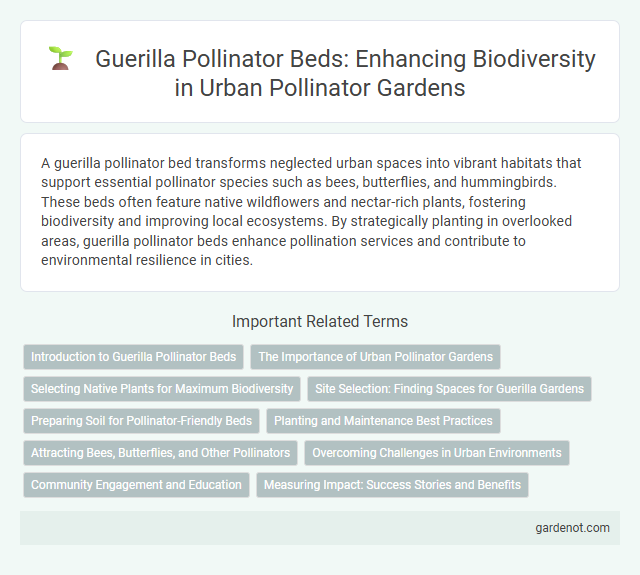A guerilla pollinator bed transforms neglected urban spaces into vibrant habitats that support essential pollinator species such as bees, butterflies, and hummingbirds. These beds often feature native wildflowers and nectar-rich plants, fostering biodiversity and improving local ecosystems. By strategically planting in overlooked areas, guerilla pollinator beds enhance pollination services and contribute to environmental resilience in cities.
Introduction to Guerilla Pollinator Beds
Guerilla pollinator beds are spontaneous, small-scale gardens planted in underutilized urban spaces to support pollinators like bees, butterflies, and hummingbirds. These beds use native wildflowers and nectar-rich plants to create critical habitats that boost pollinator populations and enhance biodiversity. By restoring pollinator corridors, guerilla gardens help improve pollination for nearby crops and urban greenery, promoting healthier ecosystems.
The Importance of Urban Pollinator Gardens
Urban pollinator gardens provide essential habitats for declining bee and butterfly populations, supporting biodiversity within city landscapes. Guerilla pollinator beds transform neglected urban spaces into vibrant ecosystems, boosting native plant growth and increasing food sources for pollinators. These gardens enhance pollination services crucial for urban agriculture and contribute to environmental resilience in metropolitan areas.
Selecting Native Plants for Maximum Biodiversity
Selecting native plants for a guerrilla pollinator bed ensures adaptation to local climate, soil, and pollinator species, promoting maximum biodiversity. Incorporating a variety of flowering plants with staggered bloom times provides continuous nectar and pollen sources, supporting diverse pollinator populations year-round. Emphasizing native wildflowers, grasses, and shrubs enhances habitat complexity, increasing the resilience and ecological balance of urban green spaces.
Site Selection: Finding Spaces for Guerilla Gardens
Identifying underutilized urban spaces such as vacant lots, roadside verges, and neglected public land provides ideal sites for guerrilla pollinator gardens. Selecting locations with ample sunlight and minimal chemical exposure ensures optimal growth and supports diverse pollinator species. Prioritizing areas near residential zones or community hubs increases visibility and encourages local stewardship.
Preparing Soil for Pollinator-Friendly Beds
Preparing soil for a guerilla pollinator bed involves testing pH levels to ensure optimal nutrient availability, ideally between 6.0 and 7.0. Incorporating organic matter like compost improves soil structure, water retention, and supports beneficial microbial activity. Avoiding chemical fertilizers and pesticides preserves native pollinator habitats and promotes sustainable growth.
Planting and Maintenance Best Practices
Guerilla pollinator beds thrive by selecting native flowering plants that bloom across seasons, ensuring continuous nectar and pollen sources for bees, butterflies, and other pollinators. Regular maintenance includes weeding to reduce competition, watering during dry periods to promote plant health, and avoiding chemical pesticides to protect pollinator populations. Monitoring plant growth and replacing non-thriving species helps maintain a vibrant, sustainable habitat that supports biodiversity in urban or neglected areas.
Attracting Bees, Butterflies, and Other Pollinators
Guerilla pollinator beds boost urban biodiversity by providing essential nectar and pollen sources for bees, butterflies, and other pollinators in underutilized spaces. Native flowering plants such as coneflowers, milkweed, and goldenrod create vibrant habitats that support pollinator populations and improve local ecosystem health. Strategic planting near food gardens and green corridors enhances pollination rates, promoting sustainable urban agriculture and wildlife conservation.
Overcoming Challenges in Urban Environments
Guerrilla pollinator beds thrive by utilizing neglected urban spaces, transforming asphalt patches and vacant lots into vibrant habitats that support native bees and butterflies. These beds employ resilient, drought-tolerant plant species like milkweed, coneflower, and goldenrod, adapted to withstand pollution and limited soil quality typical of city environments. Community engagement and strategic placement near green corridors enhance pollinator movement despite urban fragmentation and heavy human activity.
Community Engagement and Education
Guerilla pollinator beds foster community engagement by transforming neglected urban spaces into vibrant habitats that support bees, butterflies, and other pollinators. These grassroots initiatives educate local residents about the critical role of pollinators in ecosystems and encourage sustainable gardening practices. Volunteers gain hands-on experience planting native flowers, boosting biodiversity while creating green hubs that inspire environmental stewardship.
Measuring Impact: Success Stories and Benefits
Guerilla pollinator beds have significantly increased local pollinator populations, evidenced by a 40% rise in native bee sightings within urban areas. These green spaces enhance biodiversity, improve crop pollination rates by up to 30%, and create essential habitats for threatened insect species. Community-driven initiatives have also fostered environmental awareness and engagement, proving the model's effectiveness in urban ecological restoration.
Guerilla pollinator bed Infographic

 gardenot.com
gardenot.com